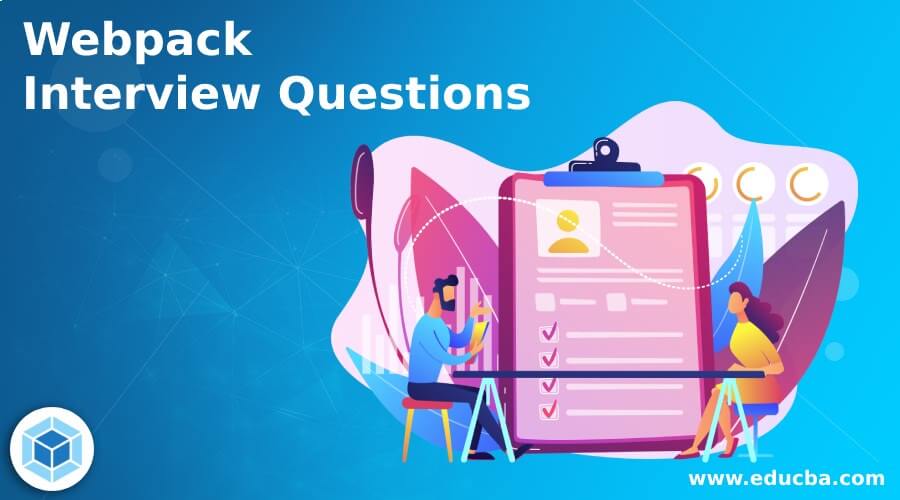Updated April 17, 2023

Introduction to Webpack
The following article provides an outline for Webpack Interview Questions. Webpack is a JavaScript module bundler that is free and open-source. “Webpack” generates static assets for modules with dependencies. As a result, web developers can use a modular approach to develop their web applications. These assets are then transformed into a format that’s easy to consume through a browser. The sum of Webpack’s parts is its true strength.
Part 1 – Webpack Interview Questions (Basic)
This first part covers basic interview questions and answers:
Q1. How can webpack’s construction speed be increased?
Answer:
- A common chunkplugin is used in the case of multiple entries to extract public code.
- Externals configuration allows you to extract common libraries.
- To precompile NPM packages that we will reference but never modify, use dllplugin and dllreferenceplugin.
- Multi-threaded compilation with happypack.
- Improve compression speed of uglifyplugin by using webpack – uglify – parallel. A multi-core parallel compression algorithm is used by webpack uglify parallel in order to improve compression speed.
- Reduce redundant code by using tree shaping and scope hosting.
Q2. Why do we need to use loaders in webpack?
Answer:
- In a loader, the source code of a module is transformed. Modules written in a variety of languages and preprocessors can be loaded by webpack using loaders.
- When loading non-javaScript modules, loaders tell webpack how to include these dependencies in bundles.
Q3. What is plugin in webpack?
- In a variety of ways, plugins can be used to customise webpack’s build process.
- As a JavaScript object, a webpack plugin has an apply property. By calling the apply method, which is called by the webpack compiler, you can access the entire compilation lifecycle.
- A number of built-in plugins are available under the Webpack menu. { webpack.[plugin-name] }
Q4. Explain the difference between chunkhash and hash.
Answer:
- For each build, [hash] will generate a unique hash.
- To generate unique hashes for each chunk, replace [hash] with [chunkhash]. As an alternative to downloading the vendors (dependencies) file again, you can update your application code without having to download the vendors (dependencies) file again.
Q5. How does webpack differ from other build tools such as gulp or grunt?
Answer:
- When used instead of Gulp or Grunt, ebpack bundles modules.
- As a result, developers can adjust builds to specific situations and workaround problems that don’t work out of the box.
- Webpack offers more flexibility and advanced functionality for modern front-end projects, compared to Grunt.
- Loaders and plugins are used to extend the functionality of the core.
Q6. What do you mean by webpack?
Answer:
- A module bundler for JavaScript applications, webpack bundles modules into a single package.
- Every module in your application is built recursively by Webpack, which then packs them all into a small number of bundles.
Part 2 – Webpack Interview Questions (Advanced)
Let us now have a look at the advanced interview questions:
Q7. In what way does webpack create a dependency graph?
Answer:
- Webpack treats any dependency between files as a dependency.
- Your application’s entry point(s) is the starting point for webpack’s recursive dependency graph-building (s).
Q8. Do webpack configuration file can contain multiple entry points?
Answer:
- Yes, in the webpack we can configure multiple entry points.
Q9. Where you can use the webpack?
Answer:
- There are many benefits to using Webpack if you are building a complex Front End application with a large number of non-code assets such as fonts, images, etc.
- The overhead of Webpack might be too much for a small application with a few static assets and a single Javascript file that needs to be served to the client.
Q10. Describe the webpack runtime and manifest.
Answer:
- It maintains a runtime as well when it writes bundles.
- It includes a manifest of the files to be loaded at startup, which is stored in the runtime.
- As soon as the names of files change, so does the manifest.
Q11. What do you mean by the compiler?
Answer:
- There are many different types of compilers, but the most common is the Java compiler, which converts Java source code into machine code for a specific architecture (such as the Intel Pentium architecture).
- In the future, the generated machine code can be executed many times, each time against a new set of data.
- It reads an executable source programme written in a high-level programming language, along with data for the programme, and runs the programme against this data to produce results.
- The Unix shell interpreter, for example, is a programme that runs interactively commands from the operating system.
Q12. Describe the mechanism that causes trees to tremble?
Answer:
- There is a lot of unused code floating around when we import and export modules in Javascript. During the build process, unused modules will not be included in the bundle due to tree shaking or dead code elimination.
- “Unused module” is a term used by tools like webpack that detect dead code but do not remove it. Webpack relies on minifies to clean up dead code, one of which is the UglifyJS plugin.
Recommended Articles
This is a guide to Webpack Interview Questions. Here we discuss the introduction and basic & advanced webpack interview questions. You may also have a look at the following articles to learn more –
